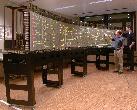 |
 |
||
|
|
|
||
|
|
It was in 1948 that Alan Turing wrote a little-known report entitled "Intelligent Machinery". At that time, he was employed at the National Physical Laboratory (NPL) in London where he worked on the design of an electronic computer - the Automatic Computing Engine (ACE). Turing never had great interest in publicizing his ideas, so the paper went unpublished until 1968, 14 years after his death. Few people know that the "Intelligent Machinery" paper contains a fascinating investigation of different connectionist models that would today be called neural networks. It is amazing that his employer at the National Physical Laboratory, Sir Charles Darwin, grandson of the well-known English naturalist, dismissed the manuscript as a "schoolboy essay". In describing randomly connected networks of artificial neurons, Turing has written one of the first manifests of the field of artificial intelligence (although he did not use this term). Turing's neural networks have recently been investigated in detail in a book. Turing himself called his networks unorganized machines. He basically proposed three types of machines: A-type, B-type, and P-type unorganized machines. A-type and B-type machines are Boolean networks made up of extremely simple, randomly interconnected NAND gates (i.e., neurons), each having exactly two inputs (i.e., synapses) from other neurons. The neurons are synchronized with a global clock signal. Unlike A-type networks, Turing's B-type networks have modifiable interconnections (basically a switch) and thus an external agent can "organize" these machines (by enabling and disabling connections) to perform a required job. The idea behind the introduction of B-type networks was to open the possibility of reinforcing successful and useful links and of cutting useless ones. His deeper motivation was to build structures that can learn. On the other hand, the idea of organizing an initially random network of neurons and connections is undoubtedly one of the most significant aspects of Turing's paper. Recently, Turing's neural networks have been implemented on the BioWall's reconfigurable tissue. Each of the 3200 units of the machine can be interactively configured by choosing one out of five possible functions: (1) empty cell, (2) neuron, (3) connection, (4) synapse, or (5) input cell. The user (the external supervisor) is invited to discover and affect the behavior of the unorganized B-type machine by opening and closing synapses (i.e., "organizing" the machine) and by modifying the network's inputs. All modifications occur by simply pressing on the respective touch-sensitive membranes. This application is first and foremost a demonstration of Turing's neural networks on reconfigurable hardware (to the best of our knowledge, the first one). However, it also exemplifies the fusion of the ontogenetic and epigenetic axes in a single artificial tissue. For further information
Resources
|







